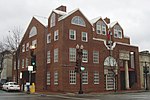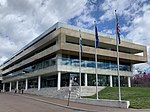Embassy of Venezuela, Washington, D.C.

The Embassy of Venezuela in Washington, D.C. is the diplomatic mission of the Bolivarian Republic of Venezuela to the United States. The embassy is located at 1099 30th Street, Northwest, Washington, D.C. in the Georgetown neighborhood.The embassy also operates Consulates-General in Boston, Chicago, New York City, San Francisco, Houston, Miami, and New Orleans.On January 23, 2019, the Nicolás Maduro-led government of Venezuela broke off diplomatic relations with the United States. Venezuelan embassies and consulates in the US are now being administered by representatives of Juan Guaidó, recognized by the US as the acting president of Venezuela during the Venezuelan presidential crisis.
Excerpt from the Wikipedia article Embassy of Venezuela, Washington, D.C. (License: CC BY-SA 3.0, Authors, Images).Embassy of Venezuela, Washington, D.C.
30th Street Northwest, Washington Georgetown
Geographical coordinates (GPS) Address Nearby Places Show on map
Geographical coordinates (GPS)
| Latitude | Longitude |
|---|---|
| N 38.903611111111 ° | E -77.058611111111 ° |
Address
30th Street Northwest 1077
20007 Washington, Georgetown
District of Columbia, United States
Open on Google Maps





